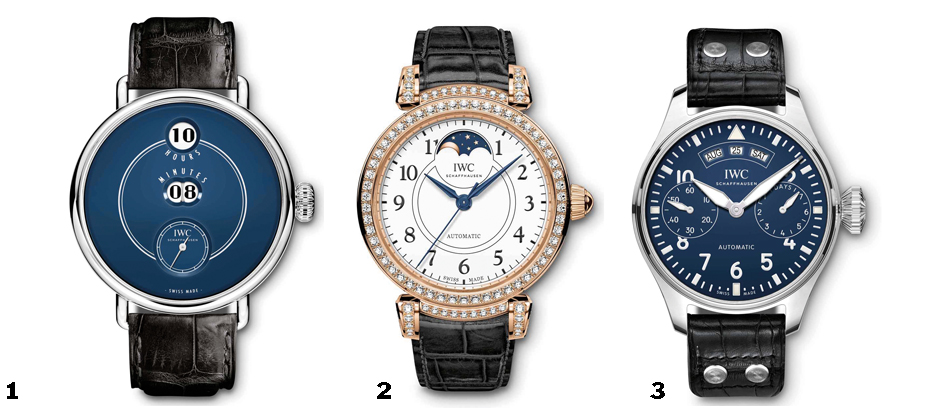Prestige issue 292, Oct-Nov 2018
With a clear focus on technology and development, the Swiss watch manufacturer IWC Schaffhausen has been producing timepieces of lasting value since 1868. The company has gained an international reputation based on a passion for innovative solutions and technical ingenuity. One of the world’s leading brands in the luxury watch segment, IWC crafts masterpieces of Haute Horlogerie at their finest, combining supreme precision with exclusive design. To celebrate its 150th anniversary, IWC Schaffhausen is launching this year a jubilee collection, comprising a total of 28 limited edition watches from the Portugieser, Portofino, Pilot’s watches and Da Vinci families with a special watch in tribute to Pallweber.

This year marks IWC 150th anniversary. IWC’s story begins with the spirit of endeavor and a bold, entrepreneurial idea: in 1868, American watchmaker Florentine Ariosto Jones founded the International Watch Company in Schaffhausen. With the aid of eminently qualified Swiss professionals, state-of-the-art machine technology and hydropower from the Rhine, his aim was to produce top quality pocket watch movements for the US market. In the summer of 1884, IWC ushered in the digital era, and the first pocket watches with jumping numerals left the workshops. They were based on the Pallweber system developed by Salzburg based watchmaker, Josef Pallweber, and showed the hours and minutes in large numerals on rotating discs. Johannes Rauschenbach Schenk, head of IWC at the time, was fascinated by this modern approach of time display and secured the patents for the handless watches. However, since toothed cogs were responsible for the energy-intensive job of advancing the display discs, the power reserve of the Pallweber pocket watches was relatively limited.
In your opinion, how did IWC evolve since you started with them? My connection with IWC started 23 years ago when I first came to Switzerland. I fell in love with the brand when I saw their watches. In 2009, I started to work for IWC in the supply chain, purchasing components for the movements and the challenge back then was in increasing the quantities. We were in a strategy of manufacturing movements and we had to increase production from 10 000 movements to 30 000-40 000 movements. Today we manufacture around 35 000 and I helped increase the production in purchasing for the supply chain for these big quantities. IWC evolved in a sense that today the market is faster, the people change their opinion faster, they are influenced by social media, the social media is influencing the tastes and trends.

«My job is to bring the dream to the wrist»
Do you really think that social media has an influence when it comes to buying watches? We have a large part of collectors writing about the brand, and 70% of the decisions to purchase are done through the Internet or social media. The question is how or who is influencing and in what direction. I think luxury has become very trendy and I find this a little bit contradictory, because luxury has a link to history, while trends are set and disappear very quickly. It’s very difficult to read the market, and understand what people expect is a new challenge.
Can you tell us about the jubilee collection? For our 150th anniversary, we present 30 references. Normally IWC unveils references in one product line, this year we are introducing novelties in four product lines: the Portugieser, the Portofino, the Da Vinci and the Pilot’s. Within 30 references, four references are completely new and cannot be assigned to any of the IWC product lines. These references have a completely new case and crown design and have a digital hour and minute display. They are a tribute to Pallweber complication. One of them is also a pocket watch. What is also very interesting about these 30 references is that they have a unifying design element: they all have lacquered dials that require about ten coats of lacquer to get the enamel look of the 20’s. White dials have black numerals and blue hands and the blue dials have white numbers and silver hands. The second common feature is the polished case. The classical watches like the Portugieser, the Portofino and the Da Vinci are already polished but if you look at the Pilot’s, they are normally sandblasted or grinded to give them the look of sportiness, but for this edition, they have the polished cases that give them the classy look. All watches come with black alligator straps and they all have the 150 years signet engraved in the back case, the oscillating rotor or in a medallion on the movement.
Is it a way for you to differentiate a Portugieser from the 150th-anniversary collection from another Portugieser? Exactly, in the jubilee collection numbers and indexes are printed, this feature is drawn from the first watches manufactured by IWC. We also have a lot of new movements: Calibre 82200, which is an automatic movement with 60 hours power reserve, introduced into the Da Vinci. Our new calibre 69000 goes into the Portugieser chronograph, definitely an iconic watch. Another new movement is the perpetual calendar with a tourbillon at 12 o’clock. What’s also special about the collection is that all models come in limited editions.
Which one is your favorite from the Jubilee collection? I am personally in love with the Big Pilot Annual Calendar, whose date only needs to be changed once a year and it has a seven days power reserve. It’s at the same time classical and sporty.
Would you say the Tribute to Pallweber is the highlight of the jubilee collection, due to its completely new aesthetic, new movement? We have a new strap, a new case design, a new movement, a new way to display time and we have three new patterns in the movement, it’s definitely the talking piece of the year.
Why do you think it took so much time for IWC to do something new, in a sense that it’s not part of one of those collections that we are talking about? I think it’s never easy to bring a new icon to the market. The history of IWC has been moving around innovation in materials, with ceramics, with titanium… Now we are bringing ceratanium, a combination of titanium and ceramic, which we introduced last year with the Aquatimer. New materials, new technology, the new movement is the heritage of IWC. Today, for the 150th anniversary we introduced a new movement in a new case design because the digital hour and minute complication do not quite fit any of the other product lines. It’s something from the past which was only known in the pocket watches, but we stopped doing pocket watches twelve years ago.
Is it just one shot in these limited editions, or do you think you might sincerely develop it in another product line? The movement is great, innovative. We will have to see…
It had to be that big as a watch? Yes, you have a movement with two barrels and we needed space for the two barrels. It’s a watch with sixty hours power reserve, in the past, the original Pallweber complication had only around 30 hours of power reserve. Interview conducted in Geneva by MARIA NADIM








